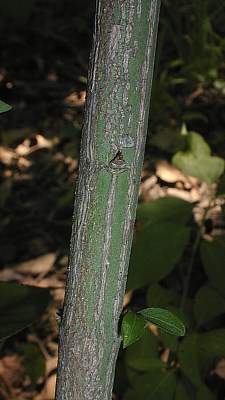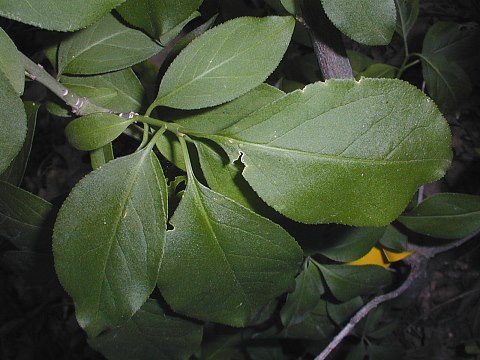Description: This is a shrub or small tree that becomes up to 25' tall. It produces ascending branches sparingly to occasionally. The central trunk and/or larger branches are covered with a thin gray bark that is slightly rough. Smaller branches are dull green with thin vertical stripes of gray bark, while young shoots are entirely green. Young shoots or small branches can be terete (round in cross-section) or 4-angled. Pairs of opposite leaves develop along young shoots and smaller branches; they are up to 4½" long and 2" across. The leaves are ovate to narrowly ovate and finely serrated or crenate. The upper surface of each leaf is dark green and hairless, while the lower surface is pale green and finely pubescent. At the base of each leaf, there is a slender petiole about ½" long. During the fall, the leaves become yellow or red.

Small forking
cymes of 7-20 flowers develop from the axils of current or former
leaves. Each flower is about 1/3" (8 mm.) across, consisting of 4
spreading
petals, 4 sepals, 4 short stamens with yellow anthers, and a pistil
with a short stout style. The petals are reddish purple and oval in
shape, while the smaller sepals are greenish purple and oval. The
blooming period occurs from late spring to early summer and lasts about
a month. The flowers are replaced by 4-lobed seed capsules that become
mature during the fall. At this time, each seed capsule splits open
into 4 parts to expose 4 fleshy red arils (fruits) that each contain 2
seeds. The seed capsules are light pink or pale purple with a smooth
surface; they later become more dark-colored. The seeds are light brown
with a smooth surface. The root system consists of a taproot. This
woody plant reproduces by reseeding itself.

Cultivation:
The preference is dappled sunlight to light shade, moist to mesic
conditions, and a fertile loamy soil.
Range & Habitat:
The native Eastern Wahoo has been found in most counties of Illinois;
it is
occasional throughout the state (see Distribution
Map). The epicenter of this woody plant's distribution is the
lower Midwest. Habitats include moist to mesic woodlands, shaded to
partially shaded riverbanks, woodland borders, wooded slopes, small
openings in wooded areas, and thickets. This species is typically found
in Maple-Basswood, Maple-Beech, and similar deciduous woodlands. It
doesn't appear to spread into disturbed areas to the same extent as
some invasive Euonymus spp. from Eurasia.
Faunal Associations:
The flowers attract small bees (mostly Halictid bees), miscellaneous
beetles, and various flies. Among these insects, the flowers are
especially attractive to flies, possibly because the color of their
petals resembles carrion or other rotting material. Typical fly
visitors include Syrphid flies, flesh flies (Sacrophagidae), Muscid
flies, blow flies (Calliphoridae), and Anthomyiid flies. These insects
feed primarily on nectar. The foliage of Eastern Wahoo is eaten by the
caterpillars of the moths Ectropis crepuscularia
(Saddleback Looper), Herpetogramma thestealis
(Pyralid Moth sp.), and Yponomeuta multipunctella
(American Ermine Moth). A recently introduced moth, Pryeria
sinicia (Euonymus Leaf Notcher), has been observed along the
East Coast of the United States, but it hasn't spread to Illinois thus
far. Other insects that feed on Euonymus spp.
include Otiorhynchus sulcatus (Black Vine Weevil)
and Unaspis euonymi (Euonymus Scale). The red fruit
of Eastern Wahoo is not especially popular with birds. However, the
Northern Flicker, Brown Thrasher, Catbird, Eastern Bluebird, Cardinal,
and Eastern Towhee eat the fruit to a limited extent (Source: Morton
Arboretum). These birds help to spread the seeds in the fruits to new
locations. White-Tailed Deer browse on the leaves and young shoots.
Photographic Location:
The northern edge of Busey Woods in Urbana, Illinois.

Comments: Other common names of this species are 'Spindle Tree' and 'Eastern Burning Bush.' The various Euonymus spp. in Illinois are either woody vines or small trees/shrubs. Some of these species are native, while others are Eurasian. In general, they have small flowers with 4-5 petals and odd little fruits with 4-5 lobes. Some of these species, including Eastern Wahoo, have unusual bark that is green, striped, and/or winged. Eastern Wahoo can be distinguished from other erect Euonymus spp. by the following combination of characteristics: 1) its leaves have petioles exceeding ¼" in length, 2) the leaves are finely pubescent on the underside, rather than hairless, 3) the bark of some branches is green with tan or gray vertical stripes, 4) the outer sides of the seed capsules are smooth, rather bumpy or warty, and 5) the flowers have 4 reddish purple petals. With respect to the last characteristic, other Euonymus spp. in Illinois have flowers with 5 petals, or their petals are white, green, or yellow.